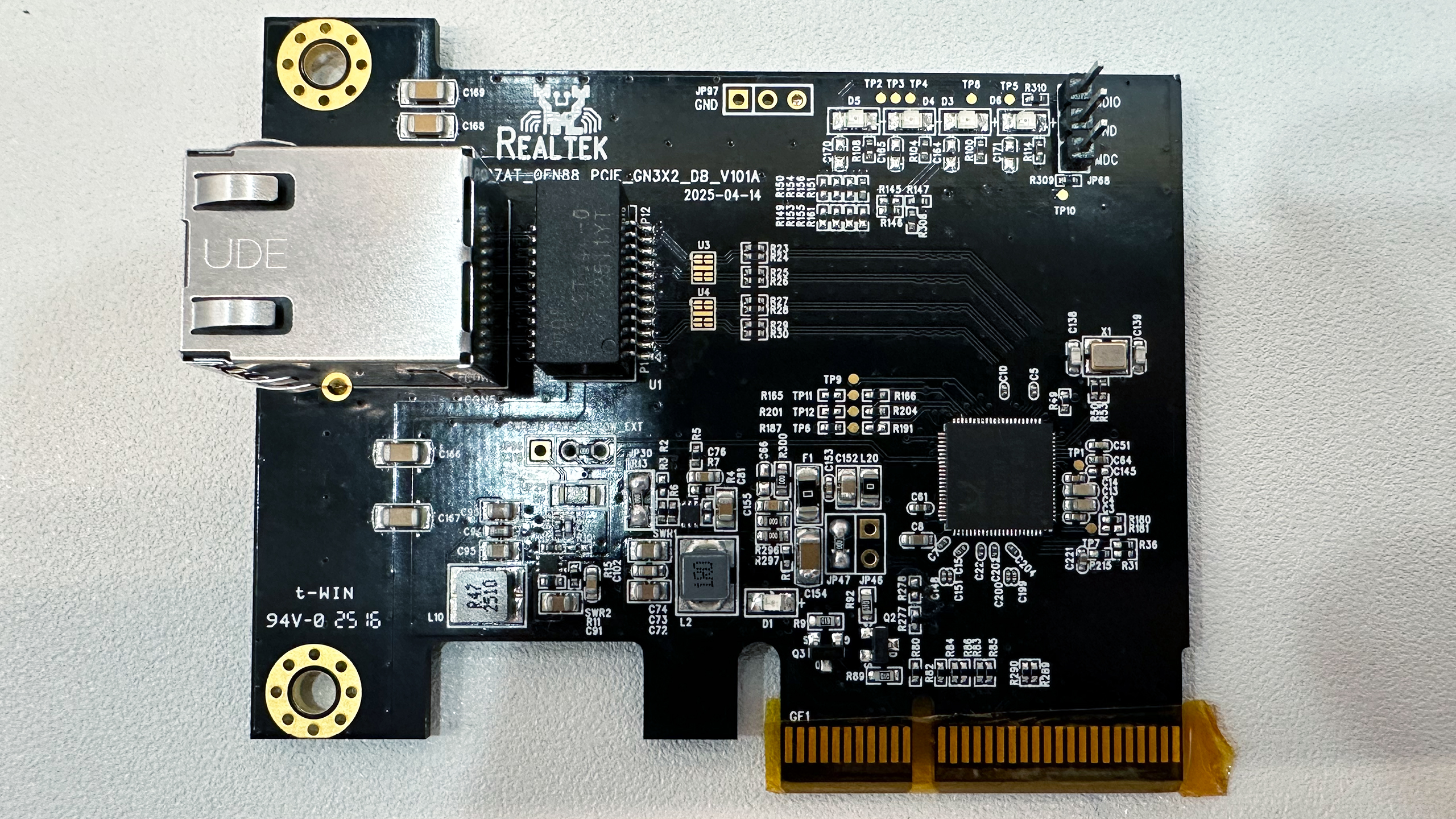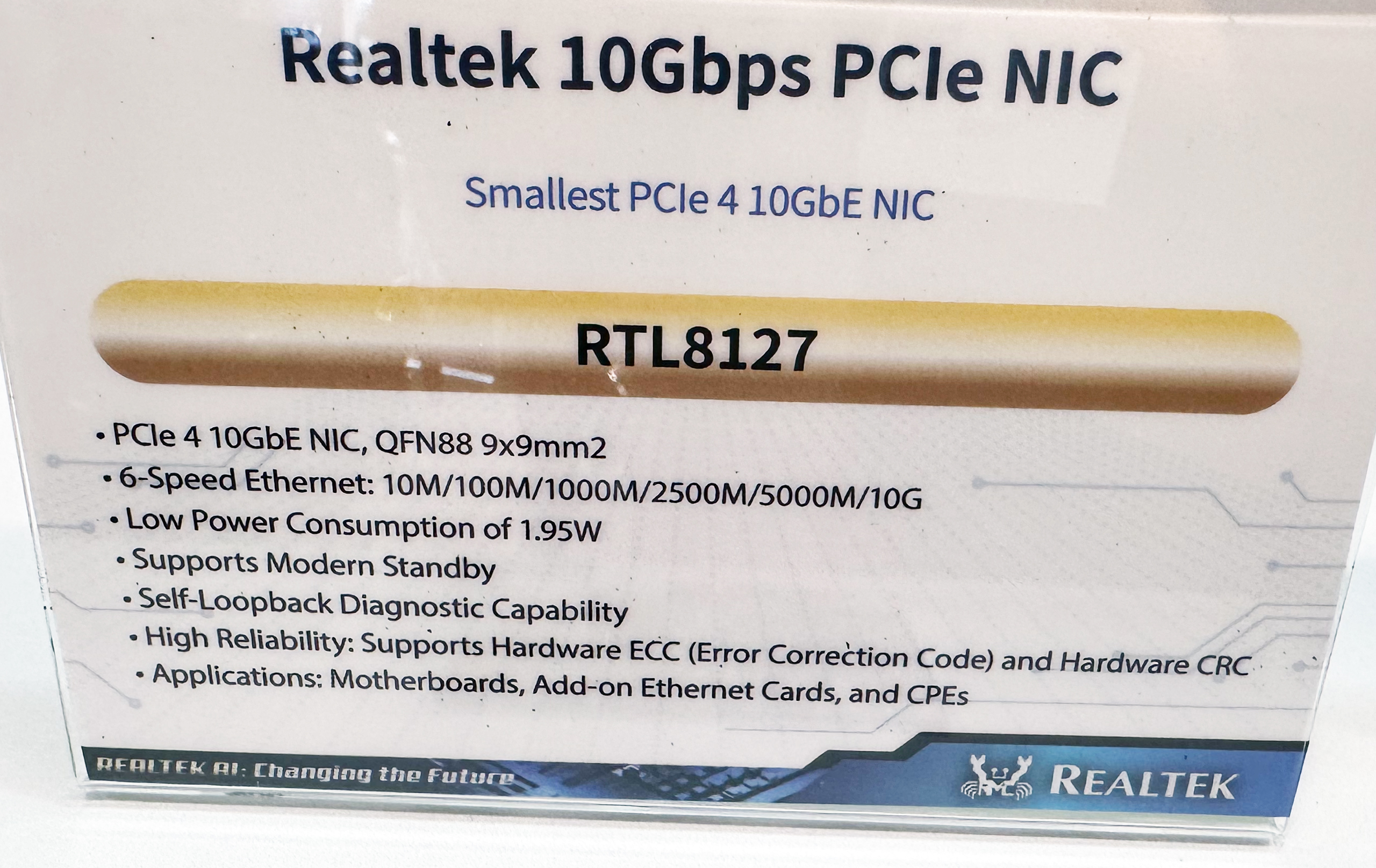Update 12:00 pm (ET) 5/29: A representative for Realtek reached out to us to clarify information about pricing and CAT5E cables used for demonstration. Apparently, the controllers will cost $15 initially, but the price will drop to $10 when quantities get higher. As for CAT5E cables, Realtek wanted to demonstrate that its hardware can work withsomeCAT5E cables. However, if it does not work in real-world cases, users will need to buy CAT6 cables.
Update: 07:30 am (ET) 5/23: Realtek itself has demonstrated its RTL8127 NIC working with an unknown switch using cheap CAT5E cables, and the company’s representatives at the booth emphasised this fact. However, we do not know which switch or router the company used. Yet, most 10GbE routers and switches are designed for CAT6 cabling.

Although there are many higher-end motherboards that feature 2.5GbE or even 5GbE network ports, only some of them feature a 10GbE network adapter due to cost concerns. However, this may change later this year as Realtek is prepping an inexpensive 10GbE controller that is aimed at motherboards. The controller is being showcased atComputex 2025.
The Realtek RTL8127 is a tiny — measuring 9mm x 9mm — network controller with a PCIe 4.0 x1 or PCIe 3.0 x2 interface that supports a wide range of Ethernet speeds, including 2.5 Gbps, 5 Gbps, and 10 Gbps. The RTL8127 controller consumes about 1.95W and supports modern standby modes, which is critical for laptops. The controller integrates hardware-level error correction (ECC) and cyclic redundancy check (CRC) features to ensure reliable connections and data integrity during transmission. Also, the unit features built-in self-loopback diagnostic functions for easier maintenance.

The 10GBase-T technology has been used primarily in servers and high-end workstations, but its adoption for more mainstream PCs has been slow, to put it mildly. Aquantia tried to popularize it for enthusiasts in the late 2010s, then it got acquired by Marvell in 2019, and while the company still sells the AQC107 silicon, it is quite expensive for motherboard integration, and add-on cards are, by definition, more expensive than integrated solutions.
Features of the RTL8127 make it ideal for a range of applications, including integration into motherboards, laptops, add-on Ethernet cards, and various customer premises equipment (CPE). Perhaps more importantly, Realtek plans to sell these chips for about $10, which will make its integration a much more appealing endeavor for motherboard makers.

“We are not selling for $10 in Q4, the current reference price varies for different customers: it would be around $15, some higher, some lower, depending on the quantity,” the representative said. “Since the quantities are not large, the $10 target might not happen this year, but it will happen when the quantity grows larger in the future.”
Of course, producers of mainboards will sell the 10GbE as a premium feature starting from late 2025 – early 2026, so expect 10GbE connectivity to be a part of higher-end offerings, and to that end, we can only wonder how much desktop motherboards with 10GbE will cost.
Of course, just like earlier, the big concern is how much the infrastructure (switches, access points, etc.) supporting 10GbE costs. At present, the cheapest 10GBase-T switch from TP-Link costs$299 at Newegg,and, of course, this switch requires CAT6 or CAT6A cables, which are also not cheap, making a 10GbE network a pretty expensive endeavor. While CAT5E cables were used during the demos we saw atComputex, users will need to make the jump to CAT6A: “Regarding the CAT5E demonstration, we just want to show that the hardware could link up to 10G withsomeCAT5E cable less than 80m in length," Realtek told us. “[To demonstrate that the] customer has a chance to use their old cable, but if it does not work, they still need to buy a standard CAT6A cable.”
Get Tom’s Hardware’s best news and in-depth reviews, straight to your inbox.
Then again, if there are a lot of motherboards with a cheap 10GbE NIC, demand for switches goes up, and they will get cheaper. However, we can only wonder when this time comes.
FollowTom’s Hardware on Google Newsto get our up-to-date news, analysis, and reviews in your feeds. Make sure to click the Follow button.
Anton Shilov is a contributing writer at Tom’s Hardware. Over the past couple of decades, he has covered everything from CPUs and GPUs to supercomputers and from modern process technologies and latest fab tools to high-tech industry trends.